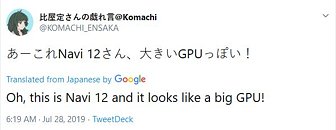- Joined
- Oct 9, 2007
- Messages
- 47,638 (7.44/day)
- Location
- Dublin, Ireland
| System Name | RBMK-1000 |
|---|---|
| Processor | AMD Ryzen 7 5700G |
| Motherboard | Gigabyte B550 AORUS Elite V2 |
| Cooling | DeepCool Gammax L240 V2 |
| Memory | 2x 16GB DDR4-3200 |
| Video Card(s) | Galax RTX 4070 Ti EX |
| Storage | Samsung 990 1TB |
| Display(s) | BenQ 1440p 60 Hz 27-inch |
| Case | Corsair Carbide 100R |
| Audio Device(s) | ASUS SupremeFX S1220A |
| Power Supply | Cooler Master MWE Gold 650W |
| Mouse | ASUS ROG Strix Impact |
| Keyboard | Gamdias Hermes E2 |
| Software | Windows 11 Pro |
AMD is developing a larger GPU based on its new "Navi" architecture to power a new high-end graphics card family, likely the Radeon RX 5800 series. The codename "Navi 12" is doing rounds on social media through familiar accounts that have high credibility with pre-launch news and rumors. The "Navi 10" silicon was designed to compete with NVIDIA's "TU106," as its "XT" and "Pro" variants outperform NVIDIA's original RTX 2060 and RTX 2070, forcing it to develop the RTX 20 Super series, by moving up specifications a notch.
Refreshing its $500 price-point was particularly costly for NVIDIA, as it was forced to tap into the 13.6 billion-transistor "TU104" silicon to carve out the RTX 2070 Super; while for the RTX 2060 Super, it had to spend 33 percent more on the memory chips. With the "Navi 12" silicon, AMD is probably looking to take a swing at NVIDIA's "TU104" silicon, which has been maxed out by the RTX 2080 Super, disrupting the company's $500-700 lineup once again, with its XT and Pro variants. There's also a remote possibility of "Navi 12" being an even bigger chip, targeting the "TU102."

View at TechPowerUp Main Site
Refreshing its $500 price-point was particularly costly for NVIDIA, as it was forced to tap into the 13.6 billion-transistor "TU104" silicon to carve out the RTX 2070 Super; while for the RTX 2060 Super, it had to spend 33 percent more on the memory chips. With the "Navi 12" silicon, AMD is probably looking to take a swing at NVIDIA's "TU104" silicon, which has been maxed out by the RTX 2080 Super, disrupting the company's $500-700 lineup once again, with its XT and Pro variants. There's also a remote possibility of "Navi 12" being an even bigger chip, targeting the "TU102."

View at TechPowerUp Main Site




 .
.
